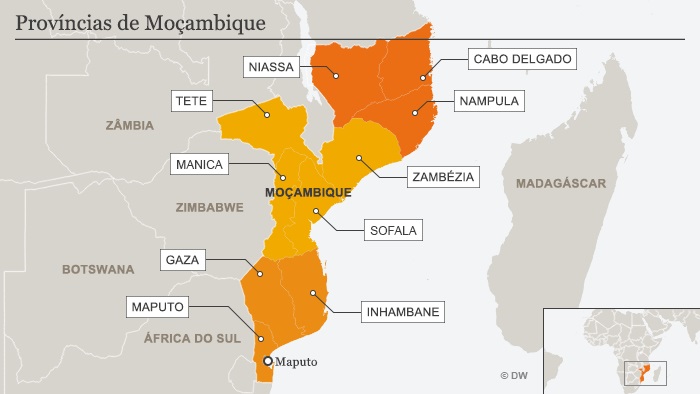Mozambique: Chapo swears in new members of Human Rights Commission
Mozambique: Final registration figures show 5.9 million new voters

Map: DW
About 5.9 million new Mozambican voters registered in this year’s voter registration which ran from 15 April to 30 May.
Speaking at a Maputo press conference on Wednesday, the General Director of the Electoral Administration Technical Secretariat (STAE), Felisberto Naife, said the exact number of new registrations in the 46 day period was 5,895,901 – which was 80.31 per cent of the target figure of 7.34 million.
The highest registration was from the southern province of Gaza, which hit 103.23 per cent of its target. It was followed by Cabo Delgado, in the far north, which, despite the islamist insurgency in parts of the province, and cyclone Kenneth, which struck the Cabo Delgado coast on 25 April, managed to reach 98.15 per cent of its target. Not far behind was the central province of Zambezia, on 97.73 per cent.
The poorest result came from the northern province of Niassa, which only reached 59.77 per cent of its target. At least Niassa has the excuse of being a mainly rural, sparsely populated province. No such excuses can explain the poor results in the most highly urbanised parts of the country, Maputo province and city, which reached respectively 63.98 and 66.97 per cent of their targets.
The figures look better when the registration from last year, ahead of the municipal elections of October 2018, is added. In 2018, 6,824,582 voters registered. Thus total registration from the two years was 12,720,483 – which is 89.79 per cent of the estimated potential electorate of 14.17 million. The rankings of the provinces are much the same, with Gaza reaching 101.62 per cent of its potential electorate, followed by Cabo Delgado (98.99 per cent) and Zambezia (98.76 per cent), with Niassa bringing up the rear (77.32 per cent).
Naife said that, despite all the criticisms made of STAE, the 2018-19 registration is the second best in the country’s history. It was only beaten by the 2009 registration, which reached 90.36 per cent of that year’s potential electorate.
For comparison, the 2013-14 registration reached 89.11 per cent of the potential electorate, and the figure in 1999 was only 85.86 per cent.
Asked about the reports that in the last week of the registration dozens of posts in the northern city of Nampula were not open, Naife admitted there had been “poor performance” by the Nampula delegation of STAE.
The electoral registers went on display at the registration posts from Saturday to Tuesday. Naife said this stage in the election preparations went off without incident, but only a small number of voters bothered to check whether their names had been correctly entered into the registers.
All the data from the registration posts will now be entered into the STAE central computers, to provide a definitive voters’ roll. At this stage, Naife said, any attempt by voters to register more than once will be detected and weeded out.
The final result from the April-May registration by province was as follows (percentages in brackets):
Niassa 284,824 (59.77)
Cabo Delgado 632,132 (98.15)
Nampula 1,228,976 (72.2)
Zambezia 1,118,625 (97.73)
Tete 553,081 (70.42)
Manica 394,004 (87.09)
Sofala 383,591 (73.49)
Inhambane 344,164 (72)
Gaza 593,601 (103.23)
Maputo province 282,105 (63.98)
Maputo city 80,798 (66.97)
Total 5,895,901 (80.31)
Registration of voters in the diaspora was much higher than STAE had initially expected. There are nine countries where the Mozambican community is deemed large enough to make it worthwhile holding elections, and voters in these countries elect two members to the Mozambican parliament, the Assembly of the Republic.
STAE estimated the total potential electorate in the diaspora at 117,198, but Naife said that 214,647 had registered (183.15 per cent of the target).
Most of this is due to South Africa, the country with the largest number of Mozambican migrants. STAE estimated the Mozambican electorate in South Africa at 65,536, but more than twice that number – 147.730 – registered, which was 225.42 per cent of the target. Other Mozambican communities which reached more than 100 per cent of the STAE target were in Zimbabwe, Malawi, Tanzania and Portugal. The communities in the other four countries –Eswatini, Zambia, Kenya and Germany – fell short of the target.













Leave a Reply
Be the First to Comment!
You must be logged in to post a comment.
You must be logged in to post a comment.